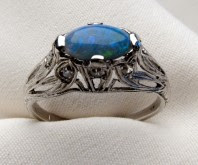Being an October baby, opals have always fascinated me and I was very fortunate to receive several at a young age. The most special being a three stone opal ring that belonged to my great grandmother Lucille.
 |
| Art Deco Opal Filigree Ring |
When I received it my grandmother gave me a talk about the fragility of opals and how I must care for this ring not only as a piece that was once my great grandmother's and therefore warranted extra attention but also as a piece of jewelry that was extremely delicate and could not be banged around or even immersed in water. And as a conscientious child and a rule follower, I did as she said, wearing it only on special occasions and taking it off when I washed my hands. But now I work in a jewelry store and I realize I owe it not only to myself but I also owe it to my clients to look closer into what is fact and what is fiction when it comes to the fragility of the opal.
Opal rates a 5.5 to 6.5 on the Moh's scale. The Moh's scale was a scale created in 1812 to characterize the hardness of various stones. It ranges from 1 to 10 with 1 being the softest, the softness of talc and 10 being the hardest, the hardness of a diamond.
 |
| Uncut Opal |
So what exactly is a 5.5 to 6.5 on this scale? Well, to give some every day hardness analogies, a penny is a 3, a knife blade is a 5, a glass window is a 5.5 and a steel file is a 6.5. So while not the hardest thing on earth, an opal is pretty darn sturdy. Much sturdier than my grandmother lead me to believe.
Still there was that warning about immersing my ring in water? My grandmother told me never to wash my hands while wearing my opal ring and I diligently did not do so. Well I have since learned this was over conscientious and unnecessary on my part. Apparently an opal is non-porous and therefore does not absorb any water. Water has a neutral effect on opals. Although they may look extra pretty while immersed. So where does this rumor about not getting your opals wet come from? It comes from the fact that many stones sold as opals at one time were actually doublets or triplets, which are composite stones. A jeweler has glued several layers of opal to a black backing to appear like one single stone. These composite opals when wet may loose their adhesion and therefore fall apart but a true opal will have no repercussions from water.
 |
| Edwardian Opal & Diamond Ring |
But what about those people who say the opposite; that you must immerse your stones in water every so often or they will crack? Again a myth taken belief. A very low percentage of stones have a very low water content when they are formed and therefore are likely to crack. But an opal goes through a lot of crackable situations before they are ever set into a piece of jewelry and therefore the fragile ones are weeded out when the stone is mined, transported or cut. A vintage or antique stone that has been set in jewelry for 50, 75 or 100 years has already proven it is not one of these stones time and time again.
The only danger I discovered is extreme temperature. So if you were thinking of setting your opal over a flame you might want to reconsider but I doubt that is the case. And very very low humidity for an extended period of time may hurt your stone but barring that you can feel comfortable wearing your stone. I plan to wear mine.

No comments:
Post a Comment